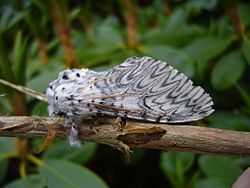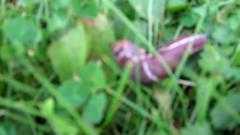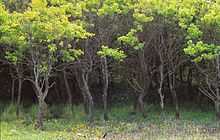Cerura vinula
| Puss moth | |
|---|---|
 | |
| Adult of Cerura vinula | |
| | |
| Mounted specimen | |
| Scientific classification | |
| Kingdom: | Animalia |
| Phylum: | Arthropoda |
| Class: | Insecta |
| Order: | Lepidoptera |
| Family: | Notodontidae |
| Genus: | Cerura |
| Species: | C. vinula |
| Binomial name | |
| Cerura vinula (Linnaeus, 1758) | |
Cerura vinula, the puss moth, is a lepidopteran from the family Notodontidae.
Description

Cerura vinula has a wingspan of 58 to 75 mm, the males are slightly smaller. They have white or yellowish-gray forewings, with dark lines. The hind wings are light gray and in the females they are almost transparent. The body is whitish-gray and bears black bands on top of the abdomen. The flight period extends from April to August depending on the altitude, in one generation. The host plants are the willow and the poplar, especially the aspen, Populus tremula.[1]
The females lay their chocolate brown 1.5 millimeters wide, hemispherical eggs on the upper side of the leaves of their food plants.
The caterpillars are about 80 mm. They are bright light green and have a blackish brown, outlined in white dorsal pattern. Young caterpillars are completely black. The abdomen ends in a tail fork with two long, dark-colored tips bearing red extendable flagellae. The moth survives the winter as a Pupa in a very solid, wood reinforced cocoon, attached to a tree or pole.
The caterpillars have a remarkable defensive behavior. When disturbed, they strike a defensive pose raising the head with a reddish area and tails with extendable flagellae. They might squirt formic acid at the attacker if the defense warning is unheeded.
-

Caterpillar
-

Caterpillar frontal view
-

Caterpillar in defensive pose
Distribution
The moth is a Palearctic ecozone species is found throughout Europe and across temperate Asia to China. It is also found in North Africa.

Habitat
This moth is mostly discovered in very dense and woodland areas.
References
Further reading
- South R. (1907) The Moths of the British Isles, (First Series), Frederick Warne & Co. Ltd., London & NY: 359 pp. online
| Wikimedia Commons has media related to Cerura vinula. |